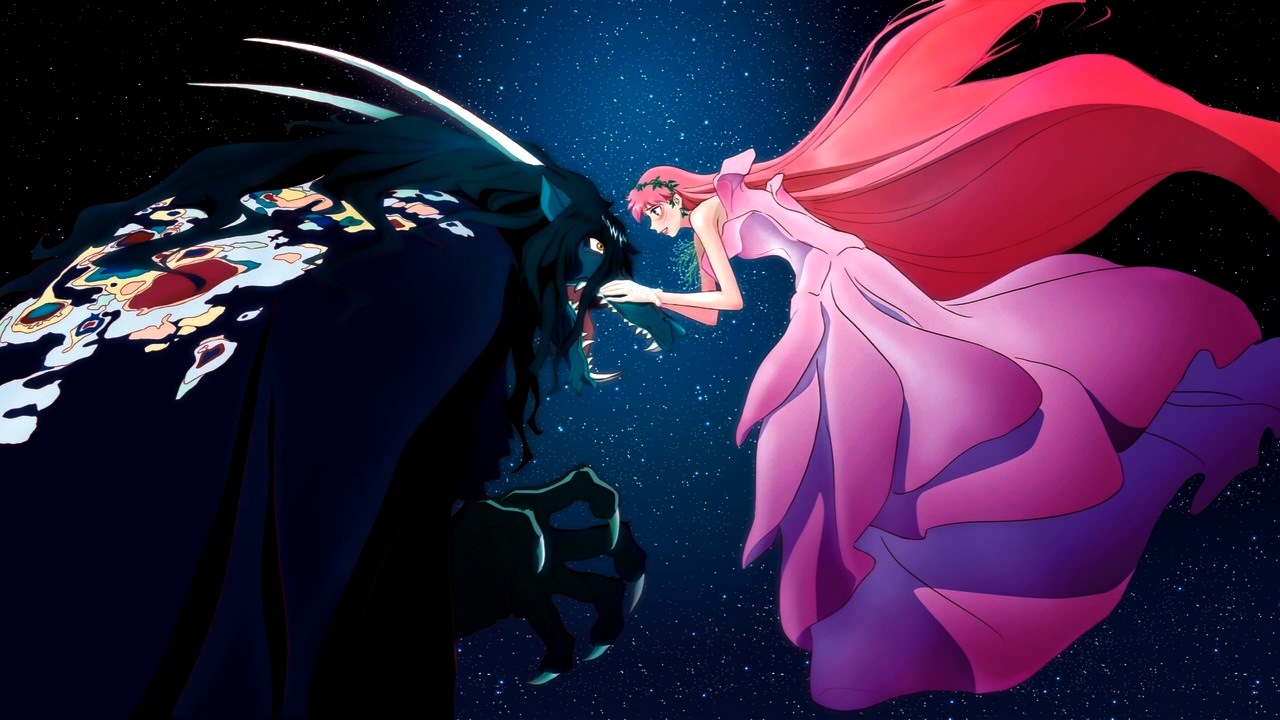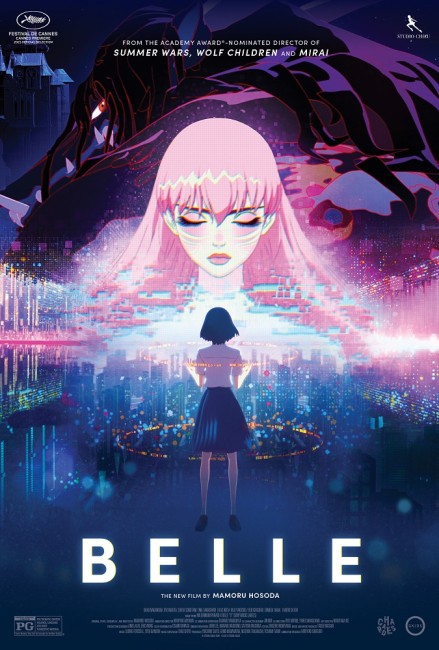(Ryu to Sobakasu no Hime)
Japan. 2021.
Crew
Director/Screenplay – Mamoru Hosoda, Producers – Genki Kawamura, Yuichiro Saito, Nozomu Takahashi & Toshimi Tanio, Music – Yuta Bandoh, Ludvig Forssell, Taisei Iwasaki & Miho SakaI, Production Design – Anri Jojo & Eric Wong. Production Company – Studio Chizu.
Plot
Susu is a teenager in high school, suffering grief after the loss of her mother several years earlier who was drowned while trying to save a boy stranded in a river. Susu discovers a Virtual Reality program known as U where a user adopts an avatar based on their biometric data known as an As. Here Susu becomes Belle and finds unexpected success by singing, something she feels unable to do in real life. She gives a virtual concert attended by masses only for this to be disrupted by Beast, a character who is defiant of authority. Belle develops a strange attraction to Beast and finds his secret castle lair. As the self-styled police of U seek to expose Beast’s identity, Susu tries to create a connection with him in the real world.
In recent years, Mamoru Hosoda has emerged at the forefront of Japanese anime directors. Hosoda first appeared as a director on the tv series Digimon: Digital Monsters (1999-2003) and co-directed the film spinoff Digimon: The Movie (2000). Hosoda subsequently went onto make the film One Piece: Baron Omatsuri and the Secret Island (2005), spun off from another anime series, and was set to direct Howl’s Moving Castle (2004) before being replaced by Hayao Miyazaki. More recently, Hosoda had a reasonable hit with the anime The Girl Who Leapt Through Time (2006) and gained increasing acclaim with the likes of Summer Wars (2009), Wolf Children (2012), The Boy and the Beast (2015) and Mirai (2018), the latter being nominated for Best Animated Film at the Academy Awards,
With Belle. Mamoru Hosoda is making a specific homage to Beauty and the Beast, in particular the Disney animated version Beauty and the Beast (1991). If the name of the title character didn’t give it away, we get specific homages such as the layout of the castle and ballroom and a replication of the dancing scene, as well as the glowing rose. There’s even an equivalent of the talking crockery of sorts in a series of small, cute undefinable creatures, as well as a peasant mob that storms the castle. The theme of Beauty and the Beast seems a particularly relevant one for Mamoru Hosoda whose films – Wolf Children, The Boy and the Beast in particular – regularly feature characters who seem divided between social acceptance and their bestial nature.
This is no straight adaptation of Beauty and the Beast. Imagine instead the fairytale translated into a social media landscape – the world of U could easily be an extension of the world of OZ in Hosoda’s Summer Wars – where Belle and the Beast are avatars adopted in a Virtual Reality realm. I do have some issues with Hosoda’s conception of the way Virtual Reality would work – the idea that a mob could trash the Beast’s castle seems meaningless when the castle is digital rather than one made of real world bricks and mortar – are there no backups in this world? I also kept asking what would happen when the security forces train the ray that forces people to reveal their true identity of their avatars – what would simply happen if the user logged out?

If the idea of a Beauty and the Beast in Virtual Reality was not enough, Hosoda then spins the idea as what is in in effect a K-Pop fantasy where Belle becomes an internet-wide singing sensation. Although part of me kept wondering how she manages to go from just a girl who goes on the internet and sings – like about every wannabe with dreams of fame posting YouTube or TikTok clips – and her song comes out with accompanying orchestra and studio engineering finish, while someone would have to have programmed the animated effects of her floating through the skies while singing on the back of a whale.
Mamoru Hosoda makes a beautiful film. While you are trying to get you head around the idea of Beauty and the Beast retold as a virtual K-Pop fantasy, he stuns with the artistry – the aforementioned image the opens the film with Belle on the back of a whale singing. The world inside U reminds of a combination of the extraordinary hyper-flat world in Hosoda’s Summer Wars and the over spilling menagerie of colourful creations in Satoshi Kon’s Paprika (2006). The visually oversaturated world of U is contrasted with the world outside, which comes with a naturalism that would not be amiss in the gentle, contemplative works of a Hayao Miyazaki, albeit with the thinner, more elongated characters preferred by Hosoda.
Hosoda delivers all of this with extraordinary artistry. The scenes flashing back to tell the story of Susu’s mother’s death have an adult emotional complexity that seems a whole world away from any Pixar film. The artwork is frequently dazzling – I particularly liked the hilarious little scene where a rumour about Susu and a school friend holding hands passes around their social circle, shown in terms of the graphics of an online war strategy game. The climactic scene where Susu is exposed as her true self and then stands up in front of the virtual audience to sing her song is a showstopper that is guaranteed to leave few dry eyes in the house.
Trailer here


